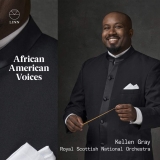Der 37-jährige afroamerikanische Dirigent Kellen Gray hat mit dem Scottish National Orchestra, dessen Associate Conductor er ist, Werke von drei der größten afroamerikanischen Komponisten des zwanzigsten Jahrhunderts aufgenommen.
Das Programm beginnt mit der Negro Folk Symphony von William Levi Dawson (1899-1990). Sie ist inspiriert von westafrikanischen Volksweisen, amerikanischen Negro Spirituals und frühen afroamerikanischen Volksrhythmen und -liedern der Gullah-Kultur. Die Komposition wurde 1934 vom Philadelphia Orchestra unter Leopold Stokowski in der New Yorker Carnegie Hall mit überwältigendem Erfolg uraufgeführt.
Die unmittelbar wirkungsvolle, sehr lebendige und gleichzeitig ungemein stimmungsvolle Interpretation des Royal Scottish National Orchestra kann diesen Erfolg nur bestätigen, die das musikalische Basismaterial idiomatisch in die symphonische Gattung einfügt und gleichzeitig soziopolitische Aspekte berücksichtigt.
Vom ersten Satz hat Dawson gesagt, er beschreibe « die Atmosphäre des eintönigen Lebens eines Volkes, dessen Körper zweihundertfünfzig Jahre lang von der Sonne gebrannt und mit der Peitsche geschlagen wurde, dessen Leben geächtet war, bevor es geboren wurde. Der zweite Satz ist mit Hope in the Night überschrieben, der letzte mit O, Le’ Me Shine, Shine Like a Morning Star.
Das kurze, elegische Lyric for Strings, von George Walker führt zu William Grant Stills Erster Symphonie, in welcher der Blues ein verbindendes Element ist. Der Musikwissenschaftler Jon Michael Spencer hat argumentiert, dass Stills symphonische Behandlung des Blues es ihm ermöglichte, « die der schwarzen Volksmusik innewohnende Würde » zu demonstrieren, und zwar als Akt der rassischen Rechtfertigung, nicht um sie als minderwertig zu kritisieren. Still selber sagte, dass « der Blues nicht unmoralisch oder trivial ist, wie manche Leute glauben wollten, sondern Ausdruck der Hoffnungen und Sehnsüchte eines einfachen Volkes, das sich ein besseres Leben wünscht. »
Kellen Gray und das RNSO liefern von diesem Werk eine ausgefeilte und wunderbar schwingende Interpretation.
The 37-year-old African-American conductor Kellen Gray has recorded works by three of the greatest African-American composers of the twentieth century with the Scottish National Orchestra, of which he is Associate Conductor.
The program opens with the Negro Folk Symphony by William Levi Dawson (1899-1990). Inspired by West African folk tunes, American Negro spirituals, and early African American folk rhythms and songs of the Gullah culture, it was premiered in 1934 by the Philadelphia Orchestra under Leopold Stokowski at New York’s Carnegie Hall to overwhelming acclaim.
The Royal Scottish National Orchestra’s immediately effective, highly vivid and at the same time immensely atmospheric interpretation can only confirm this success, fitting the basic musical material idiomatically into the symphonic genre while taking socio-political aspects into account.
Of the first movement Dawson has said it describes the « atmosphere of the humdrum life of a people whose bodies were baked by the sun and lashed with the whip for two hundred and fifty years; whose lives were proscribed before they were born. » The second movement is entitled Hope in the Night, the last O, Le’ Me Shine, Shine Like a Morning Star.
The short, elegiac Lyric for Strings, by George Walker leads to William Grant Still’s First Symphony, in which blues is a unifying element. Musicologist Jon Michael Spencer has argued that Still’s symphonic treatment of the blues enabled him to demonstrate « the inherent dignity” of black folk music « as an act of racial vindication, not to critique it as inferior. » Still himself said that « the Blues were not immoral or trivial, as some people wanted to believe, but instead an expression of the hopes and yearnings of a lowly people, wanting a better life. »
Kellen Gray and the RNSO deliver a polished and wonderfully resonant interpretation of this work.
























